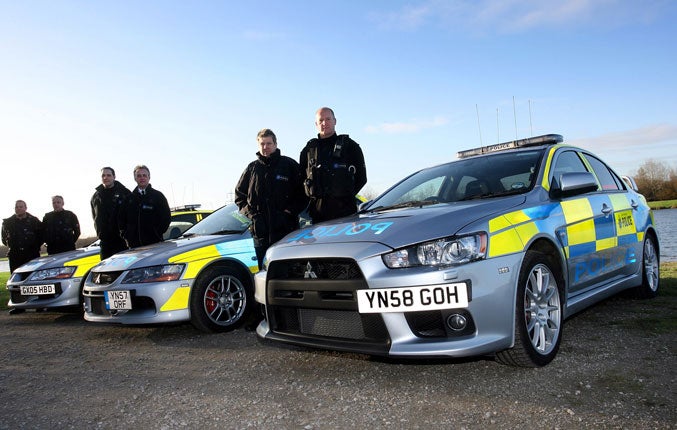A force to be reckoned with
Mitsubishi's customised police vehicles

The Mitsubishi Lancer Evo is among the stars of Channel 5's Police Interceptors series, which follows the high-speed interception unit of Essex Police.
The Evo is a fast, fearsome machine that must surely make any criminal think twice about trying to outrun the cops on the Chelmsford Bypass or Southend Arterial Road. At the other end of the scale, if you've travelled much on England's motorways and trunk roads over the past five years or so, you've probably seen big 4x4s steadily patrolling the network at a constant 60mph on behalf of the Highways Agency. Their markings are similar to police vehicles, but they are actually used by the agency's traffic officers, whose job is to keep things moving rather than nick errant motorists. Many of these vehicles are Mitsubishi Shoguns.
What the Essex Police Evo and Highways Agency Shogun have in common is that they both come from the Mitsubishi Specialist Vehicle Operations (MSVO) outfit, which has served the specialist fleet market since 2002 by providing specially adapted versions of the company's vehicles. Initially, MSVO was based at Mitsubishi's UK headquarters in Cirencester but moved to larger premises near Stroud to handle an increasing workload. The operation has a team of around half a dozen master technicians and facilities including eight vehicle ramps, a fabrication unit, spray booths, a parts store and secure vehicle compounds.
The aim is to provide a one-stop shop to bring together the various elements involved in adapting a vehicle for specialist use by amber-light organisations, such as public utilities, and blue-light organisations, such as the police service. The advantage of this approach for the customer is they only need to maintain contact with a single organisation should an issue arise requiring support or work under warranty.
Standard patrol cars are usually supplied by the mainstream car brands, but Mitsubishi is well-positioned to compete for much of the remainder of utilities' and emergency services' business, since it boasts an extensive range of 4x4s and pickup trucks. After winning a tender, the company typically works to a 12-week lead time. The work carried out can vary enormously, with some customers wanting a comprehensive package, while others might ask Mitsubishi to prepare a car with certain features that is then passed on for further conversion by another specialist company. Customers will often vary in terms of the detail, such as the number and type of blue lights required. There are also differences dictated by the precise uses to which the vehicles are put. For example, some will carry police dogs, so need to be kitted out with dog guards, rubber mats and other equipment, while the conversion process will be different for a car that will eventually be used by firearms officers, or for traffic work, which involves transporting lots of big plastic cones.
Among the Mitsubishi models used by the police, the quickest – the Lancers, Evolution X (watch out for those in South Yorkshire) and Ralliart – are used in relatively small numbers, while the 4x4s have traditionally been the best sellers. The Shogun is popular for traffic work and the L200 pickup is often chosen for rural areas and dog-carrying conversions. Recently, though, there has been growing interest in Mitsubishi's "softer" sports-utility vehicles, the Outlander and the ASX, which offer advantages such as a lower load surface.
One Mitsubishi model that's been receiving a lot of interest from police forces is the i-MiEV; a battery-powered urban runabout slightly smaller than a Mercedes A-class. This might seem surprising, but UK public sector buyers tend, apparently, to attach a great deal of weight to emissions levels, an area where electric vehicles score strongly. Mitsubishi has been exhibiting demonstrator versions of the i-MiEV in police markings around the country since 2009. As a car with a top speed of around 80mph, don't expect it to be used very much for pursuit work, even though it does have great low-speed acceleration. However, there's a range of duties in urban areas for which an electric vehicle could be ideally suited. For example, it might be a good choice for police community support officers who making mainly short local journeys.
Electric cars also run almost silently, which is great for passengers, but means that other road users, especially cyclists and pedestrians, can often be caught unawares by them. That's a safety issue that manufacturers and law-makers are currently considering how to solve, such as with measures like artificial noise makers, but it's easy to see how a near-silent car might be quite handy for creeping up on criminals.
Perhaps the police cars of the future will sometimes use stealth, rather than speed, to catch their man.
Subscribe to Independent Premium to bookmark this article
Want to bookmark your favourite articles and stories to read or reference later? Start your Independent Premium subscription today.

Join our commenting forum
Join thought-provoking conversations, follow other Independent readers and see their replies